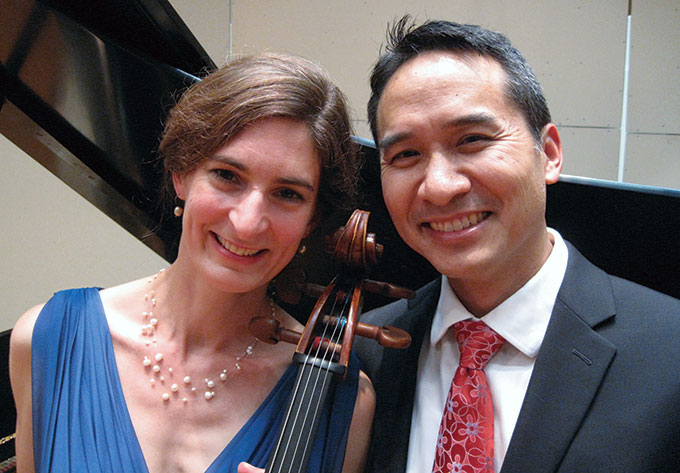Cello a la Russe
by Jan Jezioro

Cellist Natasha Farny brings Russia to Vienna
This season’s final Friends of Vienna concert on Sunday, April 6 at 3:30pm in the Unity Church (1243 Delaware Avenue), features the welcome return of Natasha Farny, Fredonia School of Music professor of cello, and the series debut of her accompanist, Chicago-based Roosevelt University professor of piano Kuan-Hao Huang, in a recital featuring masterworks from the Russian repertoire.
“Kuang-Hao and I met in 1998 at a summer music camp in Maine,” says Farny. “We were such geeks, so after working all day, we’d meet in a practice cabin and read through great cello sonata repertoire. I guess that was a good thing since nowadays we only have a few days to rehearse before a concert. One of the sonatas we loved to play that summer in Maine was the Rachmaninoff Sonata, and we will play the luscious, beautiful slow movement from that work at the start of our concert on Sunday. We both love the wealth of Russian music that can be found for our combination and we are grateful for the great Russian cellist Rostropovich, who inspired so many composers like Prokofiev to write for the cello.
Stravinsky’s Suite italienne, originally a ballet score for Pulcinella, Farny says, was transcribed by the composer for cello and piano with the help of another great Russian cellist, Gregor Piatigorsky.
“Much of the program is theatrical and very easy to imagine as a backdrop for images either in stage or cinematic format,” she explains. “Despite its 20th-century date of composition, Suite italienne may sound a little like Mozart or Pergolesi. In fact, Stravinsky used melodies and harmonies from numerous 18th-century composers and, with his own quirky chord changes and rhythmic abruptness, stamped them as his own. This piece is from his neoclassical period, so it sounds consonant and lovely, but also darkly humorous and at times even sarcastic. Beethoven’s final cello sonata in D major pairs particularly well with this piece, even though it was written over a century earlier and the funeral march in the second movement displays his rare emotional side.
“The Prokofiev Sonata is filled with melodies, and if one knows his ballets, or the orchestral piece Peter and the Wolf, you will feel at home with this work. It contains impish music that recalls the circus in the second movement, and among other wonderful themes, one hears a sort of klezmer-sounding theme in the last movement. But it all begins with a homage, perhaps to Rostropovich, using the very lowest notes of the instrument. I was once given an image for this opening from a wonderful Russian cellist named Boris Pergamenschikov. He said that this opening with cello alone was the picture of a orthodox priest, all in black, long beard, and black mitre atop his head. Every cellist enjoys playing this resonant opening and luckily, it returns at the very end of the work, this time enshrined in clangorous church bells and effusive scales that all but emit the odor of church incense.”
About her recent tour of Brazil, Farny says, “Initially, my only thought was that I wanted to take an international trip somewhere other than Europe, where I’ve played a lot. When I received a book of Brazilian etudes in the mail, put together by two former schoolmates who live in northern Brazil, I decided to propose a visit to them. Through another Brazilian friend, who lives here in Buffalo, I suddenly found that Brazil was a place one could tour for much longer than three weeks.
“It was a little wild-west crazy to play three weeks of concerts on completely unknown instruments, but I suppose I got a taste for what it’s like to be a pianist. First of all, the cellists I visited were extremely generous and kind. Two of them loaned me their own instruments to use, and the other two cellists had additional instruments, quite playable, that I could borrow. I knew that it would be difficult, but I think I got lucky—all the instruments were in good shape. And since I had brought my own bow and a new set of strings, I was able to feel at home with each instrument pretty quickly.
“Despite the relative simplicity of their resources, many of the Brazilian cellists I met were excellent players and very hard workers. A few were playing the most challenging music to be found in the repertoire, and their success was even more impressive when one discovered the limitations of their instruments. I think students may feel more driven there because they are eager to go abroad to expand their opportunities and they practice a lot. As for audiences, the ones I saw did tend to include many younger people, perhaps because many parents have affordable childcare, which is somewhat rare in this country.”
Tickets are $10, $5 for students. More information at www.friendsofvienna.org.
blog comments powered by Disqus|
Issue Navigation> Issue Index > v13n14 (Week of Thursday, April 3) > Cello a la Russe This Week's Issue • Artvoice Daily • Artvoice TV • Events Calendar • Classifieds |









 Current Issue
Current Issue